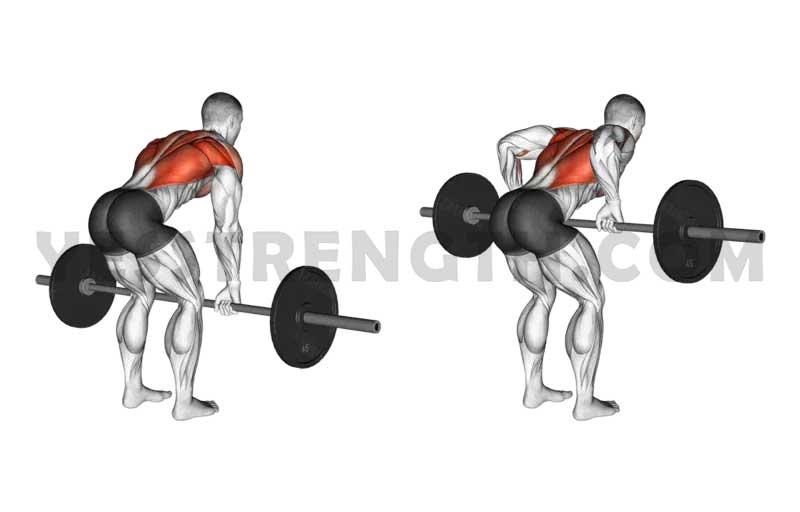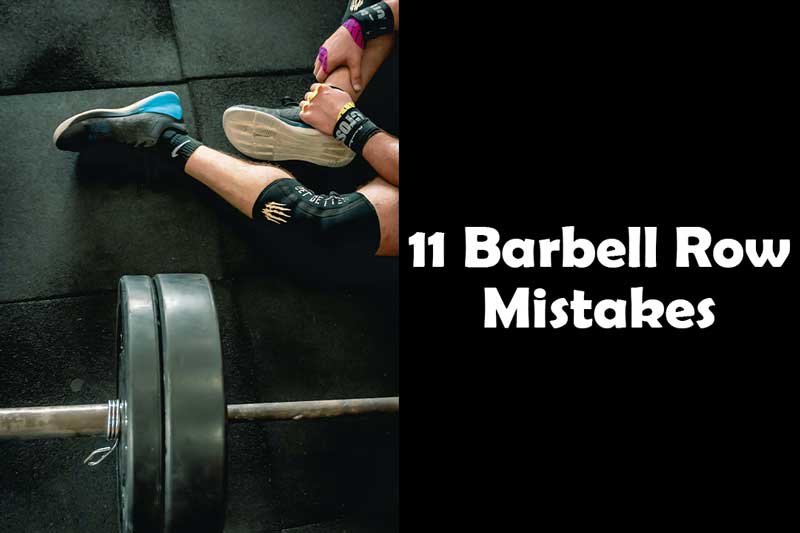The barbell row is one of the most common exercises among gym people. This exercise targets the muscles of the back, primarily the lats, rhomboids, and traps. It is an effective compound movement for developing strength and size in the upper body. However, it is very common among people to make a lot of mistakes while performing barbell row. And like any exercise, it is important to perform the barbell row with proper form and technique to maximize its benefits and minimize the risk of injury.
In this article, we will discuss 11 common mistakes people make when performing the barbell row and provide guidance on how to correct them.
11 Barbell Row Mistakes
Mistake 1: Rounded Back
One of the most prevalent mistakes during the barbell row is rounding the back. It is mostly due to lack of experience. This posture not only compromises the effectiveness of the exercise but also puts excessive strain on the spine.
To avoid this, it is essential to maintain a neutral spine position throughout the movement. Imagine a straight line from your head to your tailbone (hip), and engage your core to support your back. Focus on keeping your chest up and your shoulder blades pulled back.
Mistake 2: Using Momentum
Using momentum to lift the weight is another mistake that many individuals make. It is usually seen in people who try to lift weight that is more than they can lift without compromising the form.
It is crucial to perform the barbell row with controlled movements, rather than relying on swinging or jerking motions. This ensures that the targeted muscles are being engaged effectively. Slow and deliberate movements will provide better results and reduce the risk of injury.
Mistake 3: Incorrect Grip Width
The grip width plays a significant role in targeting specific muscles during the barbell row. A grip that is too wide or too narrow can limit the engagement of the desired muscle groups. Wrong grip can also put more emphasis on other muscles rather than the one that needs to be targeted and can lead to injury.
To optimize the exercise, use a grip that is slightly wider than shoulder-width apart. This grip width allows for proper recruitment of the back muscles while maintaining stability and control.
Mistake 4: Improper Hip Positioning
Improper hip positioning is another common mistake seen in barbell row technique. Your hips should be positioned slightly higher than your knees, and your back should be flat or slightly angled.
Avoid excessively bending at the hips or squatting down too low. This correct positioning ensures that the back muscles are properly engaged and takes unnecessary strain off the lower back.
Mistake 5: Pulling with the Arms
Many individuals mistakenly rely too heavily on their arms when performing the barbell row, neglecting the primary muscles of the back. It is a common mistake to fall into.
To maximize the benefits of the exercise, focus on initiating the movement with your back muscles. Imagine squeezing your shoulder blades together as you pull the barbell towards your body. This will help you engage the correct muscles and avoid overworking your arms.
Mistake 6: Neglecting Scapular Retraction
Scapular retraction is a crucial component of the barbell row exercise that is often neglected. It involves pulling the shoulder blades back and down towards the spine, effectively engaging the muscles of the upper back.
To ensure proper scapular retraction, focus on squeezing your shoulder blades together at the top of the movement. This will enhance back development and promote good posture. Once you get the hang of it, it will be very easy for you to avoid this mistake.
Mistake 7: Not Controlling the Eccentric Phase
The eccentric phase, or the lowering of the weight, is often overlooked during the barbell row. It is also often called the negative movement. However, it is equally important as the concentric phase (lifting the weight) for muscle growth and strength development.
To maximize the benefits of the exercise, control the lowering of the weight in a slow and controlled manner. This allows for greater time under tension and promotes muscle hypertrophy. If you can’t perform the eccentric movement with control, try to lose some weight off of the barbell.
Mistake 8: Lifting Too Heavy
Attempting to lift weights beyond your capacity is a common mistake that can lead to poor form and potential injuries. Lifting too heavy often puts pressure to not only the upper backs but also to other parts of the body. This can hinder the purpose of this exercise to properly hit the upper back muscles.
It is crucial to select a weight that allows you to maintain proper form throughout the exercise. Start with a weight that challenges you but still allows you to perform the movement with control and without compromising technique. Gradually increase the weight as you become more proficient.
Mistake 9: Lack of Core Stability
Core stability is essential for maintaining proper form and executing the barbell row effectively. A weak core can lead to a loss of balance and compromised technique. To improve core stability, incorporate exercises such as planks, Russian twists, and dead bugs into your training routine.
Strengthening your core will not only enhance your barbell row performance but also contribute to overall strength and stability. Having a strong core is not only good for this exercise but also for other major exercises as well.
Mistake 10: Not Hinging Far down
Not hinging far down is again a mistake many people make. It is especially common for newbies to make this mistake but even advanced people make this mistake a lot. Not hinging down as much as you can will put unnecessary load on your traps, as you are not bending enough and bending only at 45 degrees from ground or less.
You don’t want this to happen as barbell row is a back exercise and engaging too many traps is not what you want. To avoid this, bend as much as you can without rounding your back or without losing stability. Use less weight if you can’t perform with the weight you are trying to do.
Mistake 11: Neglecting the Mind-Muscle Connection
The mind-muscle connection refers to the ability to mentally focus on the working muscles during an exercise. Neglecting this connection can result in less effective muscle recruitment and diminished results. Not enough mind-muscle connection leads to unnecessary engagement of other muscle groups as well.
To improve the mind-muscle connection during the barbell row, concentrate on feeling the contraction in your back muscles as you perform the movement. Visualize the muscles working and consciously engage them throughout each repetition. Focus on squeezing your upper back muscles while doing barbell rows, especially the shoulder blades.
How to do a barbell row perfectly?

To perform a barbell row perfectly without mistakes, follow these step-by-step instructions:
- Start by standing with your feet shoulder-width apart and the barbell placed on the floor in front of you.
- Bend your knees slightly and hinge at the hips to lower your torso until it is parallel to the floor. Keep your back straight and maintain a neutral spine.
- Grasp the barbell with an overhand grip, slightly wider than shoulder-width apart. Your palms should be facing down.
- Engage your core and squeeze your shoulder blades together to maintain stability and proper form.
- Take a deep breath in, and as you exhale, lift the barbell by pulling it towards your torso. Focus on initiating the movement with your back muscles rather than your arms. Keep your elbows close to your body as you lift.
- Continue pulling the barbell until it reaches your lower chest or upper abdomen. Hold the contracted position for a brief moment, squeezing your back muscles.
- In a controlled manner, lower the barbell back to the starting position, allowing your arms to fully extend while maintaining tension in your back muscles.
Conclusion
To conclude, a barbell bent over rows is an amazing exercise, but it becomes even more effective if you do it perfectly with least mistakes. Avoiding common mistakes during the barbell row is crucial for maximizing its benefits and minimizing the risk of injury.
By focusing on maintaining proper form, engaging the correct muscles, and gradually increasing the intensity, you can develop a strong and well-defined back. Remember to prioritize technique over weight and always listen to your body. Incorporate the tips provided in this article into your barbell row workouts for improved results.
You might also wanna read:
FAQs
1) Can I perform barbell rows with a Smith machine?
Yes, barbell rows can be performed with a Smith machine. However, using a free barbell allows for a more natural range of motion and engages the stabilizing muscles to a greater extent. If you’re a beginner, you can go for a smith machine.
2) How many sets and repetitions should I perform for barbell rows?
The number of sets and repetitions depends on your fitness goals and training program. Generally, performing 3-4 sets of 8-12 repetitions is a good starting point for building strength and muscle size.
3) Should I use an underhand or overhand grip for barbell rows?
Both grips can be effective for barbell rows. However, an overhand grip with palms facing down typically places more emphasis on the upper back muscles, while an underhand grip with palms facing up targets the biceps more. Try alternating between the two.
4) Can I substitute barbell rows with dumbbell rows?
Yes, dumbbell rows can be an effective alternative to barbell rows. Dumbbell rows allow for greater range of motion and can help address muscle imbalances.
5) How often should I incorporate barbell rows into my training routine?
The frequency of barbell row training depends on your overall training program. Including barbell rows 1-2 times per week, is generally recommended for optimal results.





